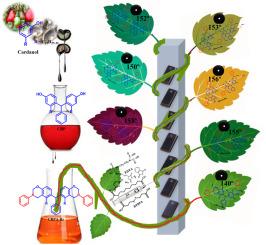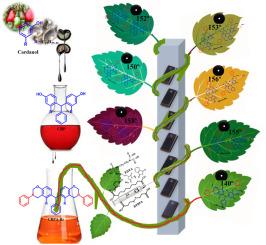一种新型交联卡双酚基聚苯并恶嗪方法:增强超疏水性和防腐涂料
IF 4.5
2区 化学
Q2 POLYMER SCIENCE
引用次数: 0
摘要
以卡双酚(CBP)为基的聚苯并恶嗪(CBPA-PBz)为基体,通过原位聚合酯化反应与酸酐、二羧酸等交联剂进行杂化,降低游离羟基。根据我们之前的报道,以腰果酚和苯甲醛为原料合成了CBP,然后以苯胺和多聚甲醛为原料,通过曼尼希缩合转化为苯并恶嗪(CBPA-Bz)单体。用等摩尔比的六种不同交联剂配制了CBPA-Bz,并在高温下进行了聚合。这提供了一个高度交联的聚苯并恶嗪网络以及CLs骨架,通过与苯并恶嗪单元在固化过程中产生的游离羟基形成酯键。6种CBPA-CL-PBz基体均具有超疏水(WCA≥150°)和良好的防腐性能,特别是CBPA-DSA-PBz对低碳钢表面的缓蚀效率达到99%以上。本文章由计算机程序翻译,如有差异,请以英文原文为准。


A novel cross-linked card-bisphenol based polybenzoxazine approach: Enhanced superhydrophobic and anticorrosive coatings
To reduce the free hydroxyl groups of card-bisphenol (CBP) based polybenzoxazine matrix (CBPA-PBz), hybridized with various cross-linkers, such as anhydride and dicarboxylic acid through esterification by in-situ polymerization. The CBP was synthesized using cardanol and benzaldehyde as per our earlier report, then it was converted into benzoxazine (CBPA-Bz) monomer using aniline and paraformaldehyde through Mannich condensation. The CBPA-Bz was formulated with equal mole ratios of six different cross-linkers (CLs), and it was polymerized at high temperature. This offers a highly cross-linked polybenzoxazine network along with the skeleton of CLs via the formation of ester linkages with free hydroxyl groups generated by the benzoxazine unit during the curing process. All six CBPA-CL-PBz matrices possess superhydrophobic (WCA ≥150°) and good anticorrosion behaviors particularly the CBPA-DSA-PBz, which exhibits above 99 % corrosion inhibition efficiency towards the protection of mild steel surfaces.
求助全文
通过发布文献求助,成功后即可免费获取论文全文。
去求助
来源期刊

Polymer
化学-高分子科学
CiteScore
7.90
自引率
8.70%
发文量
959
审稿时长
32 days
期刊介绍:
Polymer is an interdisciplinary journal dedicated to publishing innovative and significant advances in Polymer Physics, Chemistry and Technology. We welcome submissions on polymer hybrids, nanocomposites, characterisation and self-assembly. Polymer also publishes work on the technological application of polymers in energy and optoelectronics.
The main scope is covered but not limited to the following core areas:
Polymer Materials
Nanocomposites and hybrid nanomaterials
Polymer blends, films, fibres, networks and porous materials
Physical Characterization
Characterisation, modelling and simulation* of molecular and materials properties in bulk, solution, and thin films
Polymer Engineering
Advanced multiscale processing methods
Polymer Synthesis, Modification and Self-assembly
Including designer polymer architectures, mechanisms and kinetics, and supramolecular polymerization
Technological Applications
Polymers for energy generation and storage
Polymer membranes for separation technology
Polymers for opto- and microelectronics.
 求助内容:
求助内容: 应助结果提醒方式:
应助结果提醒方式:


